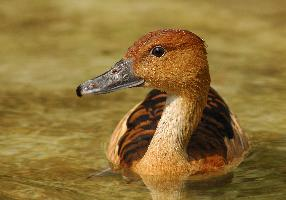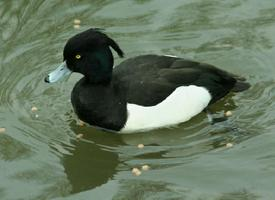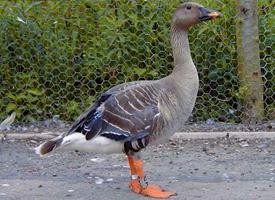
Greutăți și măsuri
| Lungime | de la 48 la 53 cm |
|---|
Descrierea animalului
The Fulvous Whistling Duck, scientifically known as Dendrocygna bicolor, is a medium-sized, intriguing species of waterfowl that belongs to the family Anatidae. This species exhibits a unique combination of physical and behavioral characteristics that set it apart from other ducks.Physically, the Fulvous Whistling Duck is notable for its long legs and neck, which give it a more elongated appearance compared to other duck species. It has a distinctive fulvous or tawny coloration that covers most of its body, with darker feathers on the back and lighter, almost creamy feathers on the underparts. The wings are relatively large and, when in flight, reveal striking black and white patterns that are visible against the bird's otherwise earthy tones. Its bill is of moderate length, gray or blue-gray in color, and slightly downturned at the tip, while its eyes are marked by a bright red or orange iris, adding a splash of color to its otherwise muted palette.
One of the most distinguishing features of the Fulvous Whistling Duck is its vocalization, from which it derives its common name. Unlike the quacks commonly associated with ducks, this species produces a clear, high-pitched whistling sound. These whistles are often heard during the evening and nighttime hours, serving as a means of communication among individuals within flocks.
In terms of habitat, the Fulvous Whistling Duck is highly adaptable, frequenting a variety of wetland environments including freshwater marshes, rice fields, and ponds. It is a cosmopolitan species, found across a broad geographical range that spans the southern United States, Central and South America, parts of Africa, and the Indian subcontinent. Despite its wide distribution, the species prefers warm climates and is largely non-migratory, although northern populations may move short distances southward during colder months.
Feeding habits of the Fulvous Whistling Duck are omnivorous but tend towards a preference for plant material. The bird feeds on seeds, grains, and aquatic plants, often foraging in shallow waters or in fields. It is known to feed at night, taking advantage of the cooler temperatures and reduced predation risk.
Breeding behavior is somewhat communal, with multiple pairs often nesting in close proximity to each other. The nests are typically built on the ground, concealed in dense vegetation near water. Both parents share responsibilities in incubating the eggs and raising the young, which are precocial and able to leave the nest shortly after hatching.
Despite facing threats from habitat loss and hunting in some areas, the Fulvous Whistling Duck is classified as Least Concern by the International Union for Conservation of Nature (IUCN), indicating that it is not currently at significant risk of extinction. This status is a testament to the bird's adaptability and the effectiveness of conservation efforts in some regions.
In conclusion, the Fulvous Whistling Duck is a fascinating and resilient species with distinctive features and behaviors. Its presence enriches the biodiversity of wetland ecosystems, and its conservation is vital for maintaining the ecological balance within these habitats.
Animale similare
Fotografii noi cu animale
Top 10 animale
- Dolphin gull (Leucophaeus scoresbii)
- Diana monkey (Cercopithecus diana)
- Moustached guenon (Cercopithecus cephus)
- Greek tortoise (Testudo graeca)
- Stone loach (Barbatula barbatula)
- Galápagos tortoise (Geochelone nigra complex)
- Japanese macaque (Macaca fuscata)
- Russian tortoise (Testudo horsfieldii)
- Common flying dragon (Draco volans)
- Galápagos penguin (Spheniscus mendiculus)


